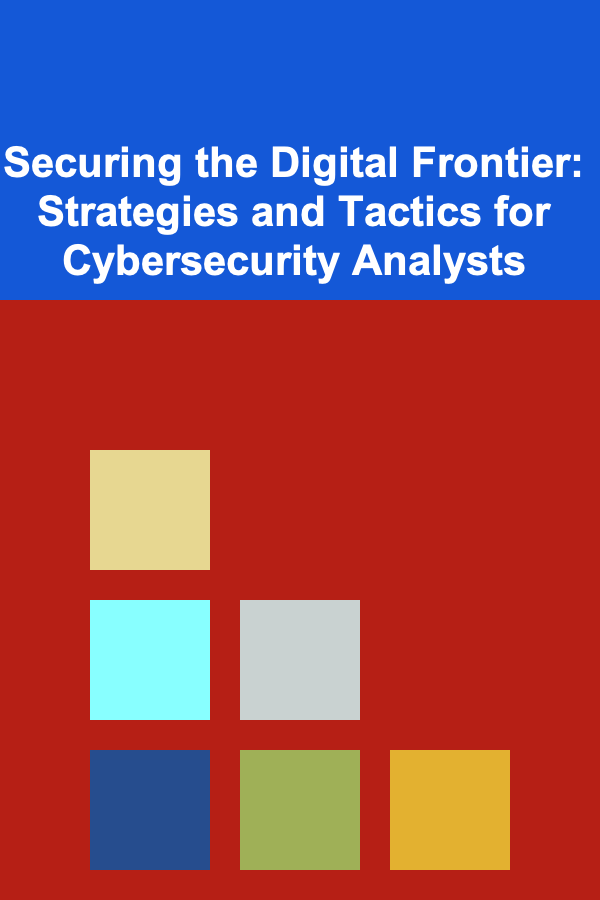
Securing the Digital Frontier: Strategies and Tactics for Cybersecurity Analysts
ebook include PDF & Audio bundle (Micro Guide)
$12.99$10.99
Limited Time Offer! Order within the next:

In today's interconnected world, the digital landscape is constantly evolving. Every day, businesses and organizations rely heavily on technology to carry out their operations, manage sensitive data, and interact with customers. As a result, the digital frontier has become an attractive target for cybercriminals, hackers, and state-sponsored actors. As a cybersecurity analyst, the responsibility of defending an organization's systems, data, and networks against an array of ever-evolving threats has never been more important. This actionable guide will explore key strategies and tactics to help cybersecurity analysts fortify defenses and secure the digital frontier.
The Current Threat Landscape
Before diving into the strategies and tactics, it's crucial to understand the current threat landscape that cybersecurity analysts must contend with. The digital frontier is filled with diverse and increasingly sophisticated threats, ranging from malware and phishing attacks to advanced persistent threats (APTs) and data breaches.
1. Malware and Ransomware
Malware remains one of the most prevalent threats. Cybercriminals often use malware to infiltrate systems, steal data, or disrupt operations. Ransomware, in particular, has emerged as a significant concern, with attackers encrypting data and demanding a ransom for its release.
2. Phishing and Social Engineering
Phishing is a common attack method where hackers impersonate legitimate institutions to steal sensitive information. Social engineering, which involves manipulating individuals into revealing confidential information, often complements phishing attacks. Both methods exploit human behavior, making them difficult to defend against.
3. Advanced Persistent Threats (APTs)
APTs are sophisticated, prolonged attacks typically carried out by well-resourced adversaries, including nation-states. APT attackers infiltrate an organization's network and maintain access for extended periods, often moving undetected. Their goals may include espionage, intellectual property theft, or even sabotage.
4. Insider Threats
An organization's employees, contractors, or other insiders can inadvertently or intentionally cause harm to the network. These threats can be especially difficult to detect, as insiders often have legitimate access to sensitive systems and data.
5. Zero-Day Vulnerabilities
Zero-day vulnerabilities are flaws in software or hardware that are unknown to the developer and, therefore, lack a patch. Cybercriminals can exploit these vulnerabilities before they are discovered and fixed, making them particularly dangerous.
Key Strategies for Cybersecurity Analysts
To effectively secure the digital frontier, cybersecurity analysts need to implement proactive and layered security strategies. The following strategies will help analysts stay ahead of attackers and mitigate risks effectively.
1. Implementing a Zero Trust Architecture
One of the most important shifts in modern cybersecurity is the adoption of a Zero Trust Architecture (ZTA). In a Zero Trust model, trust is never implicitly granted to any device or user, even if they are inside the organization's network. Every access request is verified, regardless of the user's location or role.
Key Components of Zero Trust:
- Strict Authentication: Multi-factor authentication (MFA) ensures that access is granted only to verified users.
- Least Privilege Access: Users and devices are granted only the minimal level of access required for their specific role.
- Continuous Monitoring: Instead of assuming trust, continuous monitoring of user and device activity is employed to detect abnormal behavior.
By eliminating the assumption that trusted users are always safe, Zero Trust reduces the surface area for attacks and limits the damage if a breach occurs.
2. Network Segmentation and Micro-Segmentation
Segmentation involves dividing a network into smaller, isolated segments, which helps to limit the spread of attacks. In the event of a breach, network segmentation helps prevent attackers from moving laterally across systems.
Micro-segmentation takes segmentation a step further by segmenting the network at a granular level. This means that even if an attacker gains access to one segment, they cannot access other areas of the network without additional authorization.
How to Implement:
- Use firewalls and access control lists (ACLs) to enforce segmentation at the network layer.
- Implement software-defined networking (SDN) to automatically segment the network and control traffic flow.
- Deploy solutions that monitor traffic between segments to detect unusual patterns that might indicate a breach.
Network segmentation and micro-segmentation provide an added layer of defense by ensuring that sensitive information and systems are isolated from less secure areas of the network.
3. Adopting an Integrated Security Approach: SIEM and SOAR
To stay on top of the myriad security incidents occurring in real time, cybersecurity analysts must leverage the power of integrated security solutions. Security Information and Event Management (SIEM) and Security Orchestration, Automation, and Response (SOAR) tools allow analysts to collect, analyze, and respond to security events across their infrastructure in real-time.
SIEM:
SIEM platforms collect and correlate data from various sources across the organization's network, providing a centralized view of security alerts. By analyzing logs from firewalls, servers, applications, and more, SIEM tools help analysts identify suspicious activities or emerging threats.
SOAR:
SOAR solutions take the data collected by SIEM and automate threat responses. For instance, if a SIEM tool identifies a suspicious login attempt, the SOAR platform could automatically isolate the affected system, trigger an alert, and initiate a predefined response. This level of automation ensures faster detection and containment of potential threats.
4. Threat Intelligence Sharing and Collaboration
Cybersecurity is not a battle that can be fought in isolation. Threat intelligence sharing among organizations, governments, and industry groups is critical for staying informed about emerging threats. Analysts should collaborate with trusted partners and leverage external threat intelligence feeds to enhance their detection and response capabilities.
How to Implement:
- Subscribe to threat intelligence feeds from reputable sources.
- Participate in Information Sharing and Analysis Centers (ISACs) and other industry groups to stay informed about sector-specific threats.
- Build relationships with local law enforcement and government agencies to share and receive information about potential cyber threats.
By sharing and receiving threat intelligence, analysts can stay ahead of attackers, anticipate trends, and mitigate threats before they escalate.
5. User Education and Awareness
Human error is often the weakest link in the cybersecurity chain. Cybersecurity analysts must implement continuous user education and awareness programs to reduce the likelihood of successful social engineering and phishing attacks.
How to Implement:
- Conduct regular phishing simulation tests to raise awareness about the dangers of suspicious emails.
- Provide training on recognizing common attack vectors such as spear-phishing, vishing (voice phishing), and smishing (SMS phishing).
- Educate users on the importance of strong, unique passwords and the risks of password reuse.
Empowering users to recognize threats and follow security best practices can significantly reduce the likelihood of successful cyberattacks.
Tactics for Responding to Cybersecurity Incidents
Even with the best preventive measures in place, breaches are inevitable. Cybersecurity analysts must have a well-prepared incident response (IR) strategy to quickly detect, contain, and mitigate attacks.
1. Create and Test an Incident Response Plan
An incident response plan (IRP) outlines the steps an organization will take in the event of a security breach. A well-defined IRP minimizes the impact of an attack and ensures that resources are quickly mobilized to contain and mitigate the damage.
Key Elements of an IRP:
- Preparation: Define roles and responsibilities for the incident response team, establish communication protocols, and ensure the availability of necessary tools and resources.
- Detection: Quickly identify indicators of compromise (IOCs) through monitoring systems and logs.
- Containment: Once a breach is detected, take immediate steps to isolate affected systems and prevent further compromise.
- Eradication: Remove any traces of the attack from the network, such as malicious files or backdoors.
- Recovery: Restore affected systems and services to normal operation while ensuring that the attack has been fully eradicated.
- Post-Incident Review: After the incident, conduct a thorough analysis to understand the attack's origins, assess the effectiveness of the response, and implement improvements for future incidents.
2. Forensic Investigation and Root Cause Analysis
Following a breach, performing a forensic investigation helps analysts understand how the attack occurred, what vulnerabilities were exploited, and what the attackers' objectives were. Root cause analysis identifies weaknesses in the organization's defenses that need to be addressed to prevent future incidents.
How to Implement:
- Work with digital forensics experts to gather evidence and analyze compromised systems.
- Use incident data and lessons learned to strengthen security measures and improve detection capabilities.
3. Engage in Post-Breach Communication
Clear, transparent communication is essential during and after a breach. Analysts must communicate with stakeholders, customers, and regulators to ensure they are aware of the situation and any necessary actions they must take.
How to Implement:
- Notify affected individuals as required by data breach laws.
- Provide regular updates to stakeholders on the investigation's progress and any corrective actions being taken.
- Work with legal and public relations teams to manage the public perception of the breach.
Conclusion
Securing the digital frontier requires a multi-layered approach, combining proactive defense strategies, cutting-edge technologies, and an organizational commitment to ongoing vigilance. Cybersecurity analysts are essential in safeguarding organizations against increasingly sophisticated threats. By adopting a Zero Trust Architecture, leveraging integrated security tools, sharing threat intelligence, and educating users, analysts can significantly reduce risk and bolster their organization's defenses. Additionally, a well-structured incident response plan ensures that analysts are prepared to swiftly and effectively mitigate damage in the event of a breach.
As the digital landscape continues to evolve, cybersecurity analysts must stay agile, continually adapting their strategies and tactics to stay one step ahead of cybercriminals. With the right approach, organizations can secure their digital frontiers and continue to thrive in an increasingly connected world.
Reading More From Our Other Websites
- [Home Holiday Decoration 101] How to Make Your Fireplace the Focal Point of Holiday Decor
- [Organization Tip 101] How to Create a System for Managing Home Maintenance Tasks
- [Organization Tip 101] How to Keep Your Wellness Goals Visible for Daily Motivation
- [Organization Tip 101] How to Arrange Furniture to Optimize Space
- [Rock Climbing Tip 101] How to Build a Portable Hangboard Setup for Road‑Trip Training
- [Personal Finance Management 101] How to Refinance Your Home Loan: Steps to Save Money and Improve Your Finances
- [Home Space Saving 101] How to Set Up a Capsule Wardrobe for Less Clutter
- [Home Soundproofing 101] How to Soundproof an Apartment to Avoid Noise Complaints
- [Home Holiday Decoration 101] How to Make Your Home Holiday-Ready in Just One Weekend
- [Needle Felting Tip 101] Best Needle Felting Techniques for Sculpting Real Realistic Fur -- A Detailed Tutorial

How To Use Professional Associations for Job Leads
Read More
How To Use the Two-Minute Rule for Quick Tasks
Read More
The Ultimate Guide to Making Money with Deep Learning
Read More
How to Track Travel Expenses for Business Trips
Read More
10 Tips for Planning a Competitive Esports Training Regimen
Read More
How to Invest in Tax Lien Certificates for Passive Income
Read MoreOther Products

How To Use Professional Associations for Job Leads
Read More
How To Use the Two-Minute Rule for Quick Tasks
Read More
The Ultimate Guide to Making Money with Deep Learning
Read More
How to Track Travel Expenses for Business Trips
Read More
10 Tips for Planning a Competitive Esports Training Regimen
Read More